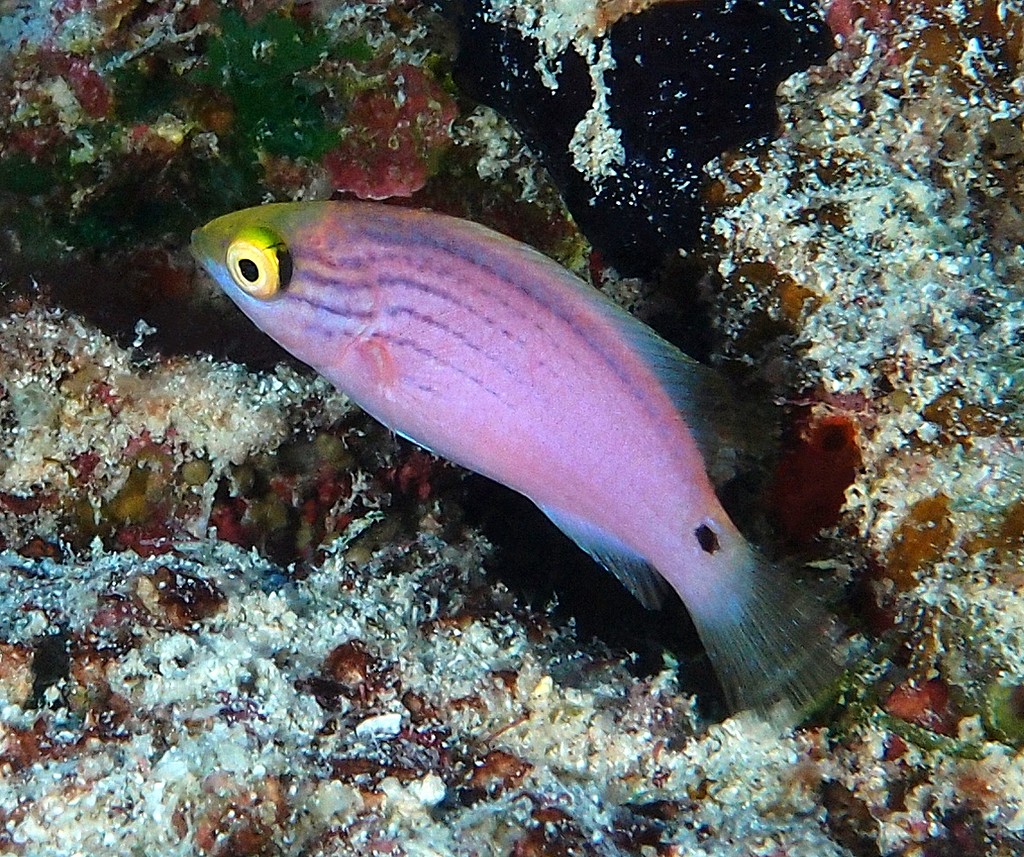CIRRHILABRUS LINEATUS - (RANDALL & LUBBOCK, 1982)
Actinopterygii (Gigaclass) > Actinopteri (Class) > Teleostei (Subclass) > Perciformes (Order) > Labroidei (Suborder) > Labridae (Family) > Cirrhilabrus (Genus)
Bluelined Wrass, Lavender fairy-wrasse, Lavender wrasse, Purplelined wrasse, Lined fairy wrasse, 紅絲絲隆頭魚, 红丝丝隆头鱼,
Description
Dorsal spines (total): 11; Dorsal soft rays (total): 9; Anal spines: 3; Anal soft rays: 9. The body of the males is bluish overall with many lines around the head, numerous fine dots on the sides, and the abdomen is yellowish. There are long blue stripes on back and abdomen and a short blue stripe at the caudal peduncle. The head is yellowish; the caudal fin is yellowish with many fine dots, and the dorsal and anal fins are bright yellow. There is a prominent black spot on the anterior base of dorsal fin. Note the black spot and irregular lines are a juvenile and female feature which disappear in the male. The pectoral fins are translucent while the pelvic fins are very long and yellow, and bluish black posteriorly. Females are pinkish with numerous dots and lines, whitish ventrally; the fins are yellow, and the dorsal and caudal fins have a reddish margin. Juveniles overall are red, with a bright yellow eye and a black spot on upper side of caudal peduncle. Max length: 12.0 cm TL. Depth range: 1-55 m; Commonly: 20-45 m.
Etymology
Cirrhilabrus: from Latin, cirrus = curl, fringe + from Latin, labrum = lip, rim or edge (type genus of family); Referring to the big lips of the fishes of the genus (from Ovid (Pūblius Ovidius Nāsō (43 BC – 17/18 AD), known in English as Ovid, was a Roman poet who lived during the reign of Augustus) and Pliny (Gaius Plinius Secundus (AD 23/24 – 79), called Pliny the Elder, was a Roman author, naturalist and natural philosopher, and naval and army commander of the early Roman Empire, and a friend of the emperor Vespasian. He wrote the encyclopedic Naturalis Historia (Natural History), which became an editorial model for encyclopedias) according to Petrus Artedi (Peter Artedi or Petrus Arctaedius (1705 – 1735) was a Swedish naturalist who is known as the "father of ichthyology")).
lineatus: from Latin, linea = line.
Original description: Cirrhilabrus lineatus Randall & Lubbock, 1982 - Type locality: Outside barrier reef west of Mato Pass, off southern end of New Caledonia, depth 30-40 meters.
Distribution
Southwestern Pacific: New Caledonia and the Loyalty Islands to the Great Barrier Reef (Australia).
Biology
Cirrhilabrus lineatus is found over coral, rock and rubble, on clear, outer-reef slopes. Cirrhilabrus lineatus is exploited in the aquarium trade.
Similar species
Cirrhilabrus pylei (Allen & Randall, 1996) - Reported from Western Pacific: Indonesia and Melanesian Archipelago (including Papua New Guinea) to Solomon Islands and Vanuatu.
Cirrhilabrus rhomboidalis (Randall, 1988) - Reported from Western Pacific: Caroline Islands and Marshall Islands.
Cirrhilabrus rubrimarginatus (Randall, 1992) - Reported from Western Pacific: Indonesia east to Philippines, Papua New Guinea, Fiji and Tonga, north to Ryukyu Islands (Japan).
Bluelined Wrass, Lavender fairy-wrasse, Lavender wrasse, Purplelined wrasse, Lined fairy wrasse, 紅絲絲隆頭魚, 红丝丝隆头鱼,
Description
Dorsal spines (total): 11; Dorsal soft rays (total): 9; Anal spines: 3; Anal soft rays: 9. The body of the males is bluish overall with many lines around the head, numerous fine dots on the sides, and the abdomen is yellowish. There are long blue stripes on back and abdomen and a short blue stripe at the caudal peduncle. The head is yellowish; the caudal fin is yellowish with many fine dots, and the dorsal and anal fins are bright yellow. There is a prominent black spot on the anterior base of dorsal fin. Note the black spot and irregular lines are a juvenile and female feature which disappear in the male. The pectoral fins are translucent while the pelvic fins are very long and yellow, and bluish black posteriorly. Females are pinkish with numerous dots and lines, whitish ventrally; the fins are yellow, and the dorsal and caudal fins have a reddish margin. Juveniles overall are red, with a bright yellow eye and a black spot on upper side of caudal peduncle. Max length: 12.0 cm TL. Depth range: 1-55 m; Commonly: 20-45 m.
Etymology
Cirrhilabrus: from Latin, cirrus = curl, fringe + from Latin, labrum = lip, rim or edge (type genus of family); Referring to the big lips of the fishes of the genus (from Ovid (Pūblius Ovidius Nāsō (43 BC – 17/18 AD), known in English as Ovid, was a Roman poet who lived during the reign of Augustus) and Pliny (Gaius Plinius Secundus (AD 23/24 – 79), called Pliny the Elder, was a Roman author, naturalist and natural philosopher, and naval and army commander of the early Roman Empire, and a friend of the emperor Vespasian. He wrote the encyclopedic Naturalis Historia (Natural History), which became an editorial model for encyclopedias) according to Petrus Artedi (Peter Artedi or Petrus Arctaedius (1705 – 1735) was a Swedish naturalist who is known as the "father of ichthyology")).
lineatus: from Latin, linea = line.
Original description: Cirrhilabrus lineatus Randall & Lubbock, 1982 - Type locality: Outside barrier reef west of Mato Pass, off southern end of New Caledonia, depth 30-40 meters.
Distribution
Southwestern Pacific: New Caledonia and the Loyalty Islands to the Great Barrier Reef (Australia).
Biology
Cirrhilabrus lineatus is found over coral, rock and rubble, on clear, outer-reef slopes. Cirrhilabrus lineatus is exploited in the aquarium trade.
Similar species
Cirrhilabrus pylei (Allen & Randall, 1996) - Reported from Western Pacific: Indonesia and Melanesian Archipelago (including Papua New Guinea) to Solomon Islands and Vanuatu.
Cirrhilabrus rhomboidalis (Randall, 1988) - Reported from Western Pacific: Caroline Islands and Marshall Islands.
Cirrhilabrus rubrimarginatus (Randall, 1992) - Reported from Western Pacific: Indonesia east to Philippines, Papua New Guinea, Fiji and Tonga, north to Ryukyu Islands (Japan).
